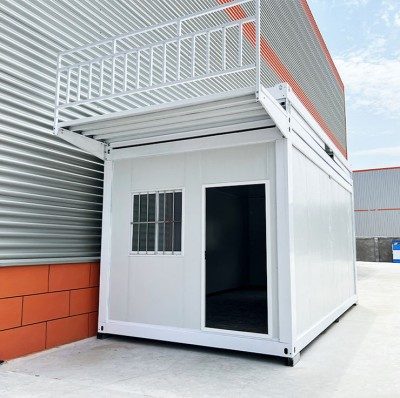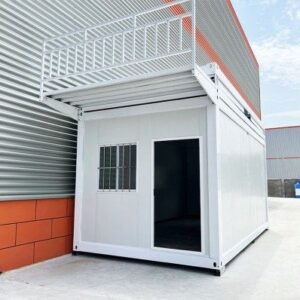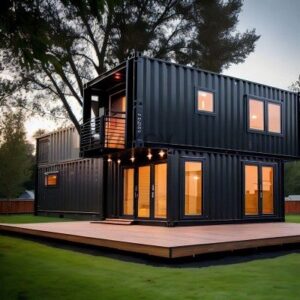When figuring out how much does a container house cost, it’s helpful to break it down by size and customization level. On average, container home construction cost per square foot tends to be lower than traditional homes, but it varies widely based on the project.
Cost per Square Foot Comparison Container House vs Traditional Home
- Container homes typically range from $100 to $200 per square foot.
- Traditional homes in the U.S. usually run between $150 and $250 per square foot, depending on location and finishes.
This means container homes can be a more affordable choice when planned efficiently.
Typical Range for Small 1-2 Container Units
- A small container home using 1 or 2 standard 20-40ft containers will generally cost between $30,000 and $70,000.
- These units are perfect for tiny homes, studios, or guest houses.
- The key cost drivers here are insulation, windows, and utility hookups.
Typical Range for Medium 3-4 Container Units
- Medium-sized container homes with 3 to 4 containers usually cost from $70,000 up to $150,000.
- These offer more living space and allow more customization like multiple rooms and a kitchen.
- Costs increase with design complexity and site conditions.
Cost Estimates for Luxury or Highly Customized Container Homes
- For a luxury or architect-designed container home, prices can climb to $200,000 or more, sometimes exceeding $300,000 for top-tier finishes and features.
- These might include high-end materials, large windows, smart home systems, or multiple levels.
Examples from Real Projects with Approximate Pricing
- A single 40ft container home in Texas was completed for around $45,000, including basic utilities and finishes.
- A multi-container home in California with 4 containers and custom solar panels cost roughly $180,000.
- A fully customized luxury container estate in Florida went for $350,000, featuring premium interiors and extensive site work.
These cost ranges reflect real container home budgets across the U.S., helping you set realistic expectations based on your desired size and style.
What Influences the Cost of a Container House
When considering how much does a container house cost, several key factors come into play that directly affect the total investment. Understanding these influences helps set realistic expectations and plan your budget effectively.
Size and Number of Containers
The size and number of shipping containers used is the most significant cost driver. A home built with one or two containers costs much less than a large modular house using multiple units. Each container typically measures 20 or 40 feet long, and prices scale with the total square footage.
Design Complexity and Customization
Simple, boxy container homes are more affordable than those with complex layouts or custom modifications. Adding multiple levels, cutting large window openings, or incorporating features like rooftop decks increases fabrication expenses.
Location and Site Preparation Costs
Building costs vary considerably based on your construction site. Costs for site grading, foundation work, accessibility, and soil conditions can add up quickly, especially in remote or difficult locations. Urban sites might have higher permitting fees but lower transport costs.
Labor Costs DIY vs Professional Construction
Labor fees contribute substantially to container home construction cost. Opting for a DIY build reduces expenses but requires skill and time. Hiring professionals ensures quality and efficiency but comes at a premium, especially in high-wage regions.
Materials and Finishes Insulation Windows Doors
The choice of materials for insulation, windows, doors, and interior finishes affects overall pricing. High-quality, energy-efficient windows and advanced insulation solutions increase initial costs but improve comfort and energy savings over time.
Utility Installation Plumbing Electricity HVAC
Installing utilities like plumbing, electricity, and HVAC systems is a necessary expense. The complexity of these systems varies by design and location, with costs influenced by local codes and connection requirements.
Permits Zoning and Legal Fees
Legal and administrative fees for permits, zoning compliance, and inspections differ by jurisdiction. Some areas have streamlined processes for container homes, while others require extensive documentation and approvals that add to the budget.
Transportation and Delivery of Containers
The price to transport and deliver containers to your building site depends on distance, accessibility, and container condition (new or used). Transport can represent a notable fraction of your initial costs, especially for heavy or oversized units.
Each of these factors interacts to form the overall container home construction cost, making it critical to evaluate each component carefully when budgeting your project. For specific container options and pricing, explore 40 foot container house models and other choices.
Container Home Cost Breakdown Where Your Money Goes
When figuring out the container home construction cost, it’s important to know exactly where your money goes. Understanding the container home cost breakdown helps you plan your budget better and avoid surprises.
Containers Purchase Price
The first major expense is buying the actual shipping containers. Prices vary based on size, condition, and location.
- Used containers typically cost between $1,500 to $4,500 each.
- New containers can be significantly higher, sometimes doubling the price.
This sets the base for your container house price per square foot.
Modification and Fabrication Costs
Turning steel boxes into livable homes requires cutting, welding, and structural reinforcements.
- Expect to spend roughly 20% to 40% of your total budget here.
- Costs depend on design complexity and customization, like adding windows, doors, or combining multiple containers.
Interior Finishes and Furnishings
Once the shell is ready, interiors make it feel like home. This includes:
- Insulation, drywall, flooring, cabinetry, and fixtures.
- HVAC, plumbing, and electrical systems.
- Finishing costs can range widely — from basic and budget-friendly to upscale luxurious options.
Site Work and Foundation Costs
The land itself impacts your total expenses. Site preparation includes:
- Clearing, grading, and foundation installation (slab, piers, or crawlspace).
- These are essential to ensure stability and compliance with local building codes.
Foundation and site work can add 10% to 15% to the overall build cost.
Utilities and Infrastructure
Connecting to municipal utilities or setting up off-grid systems has a distinct cost.
- Plumbing, electricity, HVAC setup, and septic or sewer connections.
- Depending on location, utility installation can be a few thousand dollars or more.
Additional Expenses and Unforeseen Costs
Budget for unexpected fees to avoid being caught off guard. These may include:
- Permit fees, inspection charges, and zoning adjustments.
- Transportation and delivery charges for containers.
- Extra work due to site challenges or design changes.
- It’s wise to set aside at least 10% of your budget as contingency funds.
Breaking down the expenses shows that while the price of shipping container house structures may start relatively low, total costs rise as you factor in modifications, finishes, and bureaucratic necessities common in the United States market. Knowing this helps you realistically plan your container home budget and recognize where your money is going.
Ways to Save Money on Building a Container Home
When it comes to cutting down your container home construction cost, there are smart moves you can make without sacrificing quality or comfort. Here’s how to keep your shipping container house budget in check:
Choose Standard Container Sizes with Minimal Modifications
Using standard 20ft or 40ft shipping containers saves a lot compared to custom sizes. Avoid heavy structural changes like cutting large openings or stacking multiple units if you want to keep fabrication and modification costs low. The more you alter, the higher your container home price per square foot will get.
Prioritize Essentials Before Luxury Upgrades
Focus your budget on must-haves like durable insulation, plumbing, and electricity before spending on high-end finishes or fancy appliances. Installing essentials first means you can live comfortably and add upgrades later as funds allow.
Use Recycled or Surplus Materials
Incorporating recycled or surplus building materials can reduce costs on interior finishes, windows, doors, and even furniture. This approach supports sustainability and slashes expenses without compromising style or functionality.
DIY vs Hiring Local Contractors Pros and Cons
- DIY: Saves a lot on labor costs, especially if you have basic construction skills. However, it can take more time and may require learning new skills.
- Hiring Locals: Professionals speed up the process and ensure code compliance but add to your overall container home building expenses. Look for contractors experienced specifically with container homes to avoid costly mistakes.
Optimize Design for Simplicity and Efficiency
Simple, open floor plans with fewer walls and straightforward utility layouts reduce material and labor needs. Efficient designs using natural light and smart insulation also lower long-term utility costs, making your investment more economical over time.
By focusing on these key areas, you can significantly reduce the price of shipping container house construction while creating a practical, comfortable living space tailored to your needs.
Financing Options and Budget Planning for Container Homes
When figuring out how much does a container house cost, understanding your financing options and setting a solid budget is key. Container home construction cost can vary widely, so planning your budget realistically helps avoid surprises.
Loans Mortgages and Alternative Financing for Container Homes
- Traditional mortgages can be tough to get for how much does a container house cost many lenders see them as unconventional builds.
- Specialized loans from lenders familiar with modular or prefab homes are often better suited.
- Personal loans, home equity lines, or construction loans may also work depending on your credit and plans.
- Some buyers consider private financing or crowdfunding options, especially for custom or luxury container homes.

Tips for Realistic Budgeting and Contingency Funds
To keep your container home project on track financially:
- Start with a detailed cost breakdown including containers, site prep, labor, utilities, permits, and transportation
- Include a contingency fund of at least 10-15% to cover unexpected expenses
- Prioritize essential features before luxury upgrades to control costs
- Factor in potential zoning or permit fees early to avoid delays
- Regularly review your budget as your plans or materials change
For an easy starting point, see Yichen’s range of 20ft single container houses and explore price options based on your project scale and requirements.
With a clear budget and the right financing, container home building expenses become manageable and transparent, helping your dream home become a reality.
Container House Cost vs Traditional House Is It Worth It
When comparing container house cost to traditional home prices, many buyers wonder if the savings are real and if container homes offer true value. The answer depends on several factors, but overall, container homes present some clear advantages worth considering.
Cost Savings and Faster Build Times
- Lower construction costs: Container homes often cost 20-50% less than a traditional home of similar size, mainly because the basic structure—the shipping containers—is already in place.
- Reduced labor expenses: Fewer materials and a modular setup mean less time spent on-site, cutting labor costs and speeding up the build from months to weeks in many cases.
- Simplified foundation: Containers require minimal foundation work compared to traditional homes, saving both time and money.
Environmental and Sustainability Benefits
- Repurposed materials: Using recycled shipping containers reduces waste and carbon footprint compared to new construction materials.
- Energy efficiency: With proper insulation and design, container homes can achieve high energy efficiency, lowering long-term utility bills.
- Smaller footprint: Compact designs require less land and resources, often appealing to environmentally conscious buyers.
Potential Resale Value and Investment Considerations
- Market niche: Container homes remain a niche market, so resale value depends on location and buyer interest in alternative housing.
- Customization impact: Highly customized or luxury container homes can command prices close to traditional homes, but simpler models may have limited appreciation.
- Zoning and permits: Some areas may restrict container homes, potentially complicating resale. Checking local zoning is important before investing.
| Factor | Container House | Traditional House |
|---|---|---|
| Avg. Build Cost | $100 – $200 per sq ft | $150 – $300 per sq ft |
| Build Time | 2 to 6 months | 6 to 12+ months |
| Environmental Impact | Low (recycled materials) | Higher (new materials) |
| Resale Market | Growing but niche | Established and broad |
| Labor and Material Efficiency | High due to prefab nature | Varies, often less efficient |
In , container homes offer substantial upfront cost savings, quicker construction, and environmental benefits, making them attractive for budget-conscious and eco-friendly buyers. However, resale value and local regulations should be carefully considered to ensure a sound investmen



